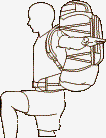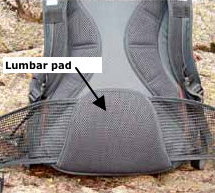Under Construction 
Internal Frame Packs:
- The only choice for snowshoeing and ski trips, off-trail scrambling,
because of less shifting and more control.
- Easier to stow in a car or airplane.
- Some now using tensioned mesh or channel to create a cooling air space
External frame packs:
- Cooler because of airflow between frame and your back.
- Great for hauling big, heavy and/or awkward loads.
- Cheaper.
|
|
Pack Bag Volume
| Length of Trip | External Frame
(cu inches and Liters) | Internal Frame |
|
2-4 Days | 1,500+ cubic in (25+ Liters) | 3,500-4,500 cubic in (57+ L) |
| 5-7 Days | 2,000+ cubic in (33+ Liters) | 4,500-6,000 cubic in (73+ L) |
| 8-10 Days | 3,000+ cubic in (39+ Liters) | 5,500+ cubic in (90+ L) |
Source: http://www.princeton.edu/~oa/ft/equipment.pdf
My old (late 60's) external frame pack is 2,600 in3 in two main compartments.
Plus 650 in3 in 5 external pockets.
External frame packs can be smaller than internal frame packs because there are spaces outside the packbag to strap large items directly to the frame.
- Under 2,000 cubic inches: Small packs for day trips like hiking and ski touring. They have no frame, a thin belt, and possibly a chest strap, and vary in the number of pockets and other features.
- 2,000 to 3,500 cubic inches: Stream-lined packs for gear-intensive day trips like climbing and winter hiking. Most have a thin foam back pad, and straps to draw the pack against your hips (stabilizer straps) and upper back (load-lifters). The design is generally minimalist to reduce weight and bulk.
- 3,500 to 4,500 cubic inches: For light packers on warm-weather weekend trips. If your gear is bulky, get a pack closer to 4,500 cubic inches for weekend trips.
- 4,500 to 6,000 cubic inches: Large enough for treks of up to a week, year-round. These popular packs vary greatly in design, features, and fit.
Source: Buying a Backpack: Fitting Solutions for Every Frame at AMC
The Complete Walker IV has a formula for computing the correct size which is available at Backpacking-guide.com
It makes a big difference if you go alone or with a group and how warm you sleep. For example: Spring or Fall 3 day trip, 150 lb hiker:
| Cold sensitivity | Number |
| Solo | 2 | 3 | ≥4 |
| warm | 2805 | 1870 | 1309 | 1122 |
| normal | 4208 | 2805 | 1964 | 1683 |
| cold | 5611 | 3741 | 2618 | 2244 |
winter trip
normal | 6734 | 4489 | 3142 | 2603 |
6 day trip
spring - normal | 5952 | 3968 | 2777 | 2380 |
The Complete Walker formula doesn't distinguish between internal or external frame packs, but since internal frame is preferred now I would guess it assumes all gear will fit inside.
Torso Length:
According to Wayne Gregory, your correct frame size can be found by measuring your torso from the seventh vertebra down the spine to the point in the small of your back which is horizontally level with the top of your hip bones. To find this point, use your fingers to trace the hip bone upwards till you feel the point where the top edge of your hip bones curve inwards, on the side of the hip, creating something of a shelf. This measurement is the torso length, especially useful to consider those packs with non-adjustable back system. In fact this system that is used throughout the outdoor industry today to measure the exact body size and to determine the correct frame's size.
HikingHelp.com/blog
 
Source: rootball at WhiteBlaze.net/forum/
Measuring torso length at REI
Small - 16 - 18 in
Medium - 17 1/2 - 20 in
Large - 19 - 22 in
See: Backpacks: Finding Your Torso and Hip Size: Expert Advice from REI
Items to consider in selecting an internal frame pack:

Source: outdoorsMalaysia.blogspot.com
Manufacturers:
Gregory Packs
Northface
JanSport
Kelty
Osprey
Lowe
REI
Granite Gear
Stores:
BackCountry
REI
Sierra Trading Post
Campmor
Links:
How to Choose a Backpack at REI
Hiking Backpacks - Making The Right Choice at Backpacking-guide.com
Find the right pack at AMC
http://www.princeton.edu/~oa/ft/equipment.pdf
Buying a Backpack: Fitting Solutions for Every Frame at AMC
How to Adjust a Backpack | eHow.com
BackpackGearTest.org - Packs
last updated 5 Sep 2009
|
 Recreation
Recreation
 Hiking & Camping
Hiking & Camping
 Backpacks
Backpacks
 Recreation
Recreation
 Hiking & Camping
Hiking & Camping
 Backpacks
Backpacks


